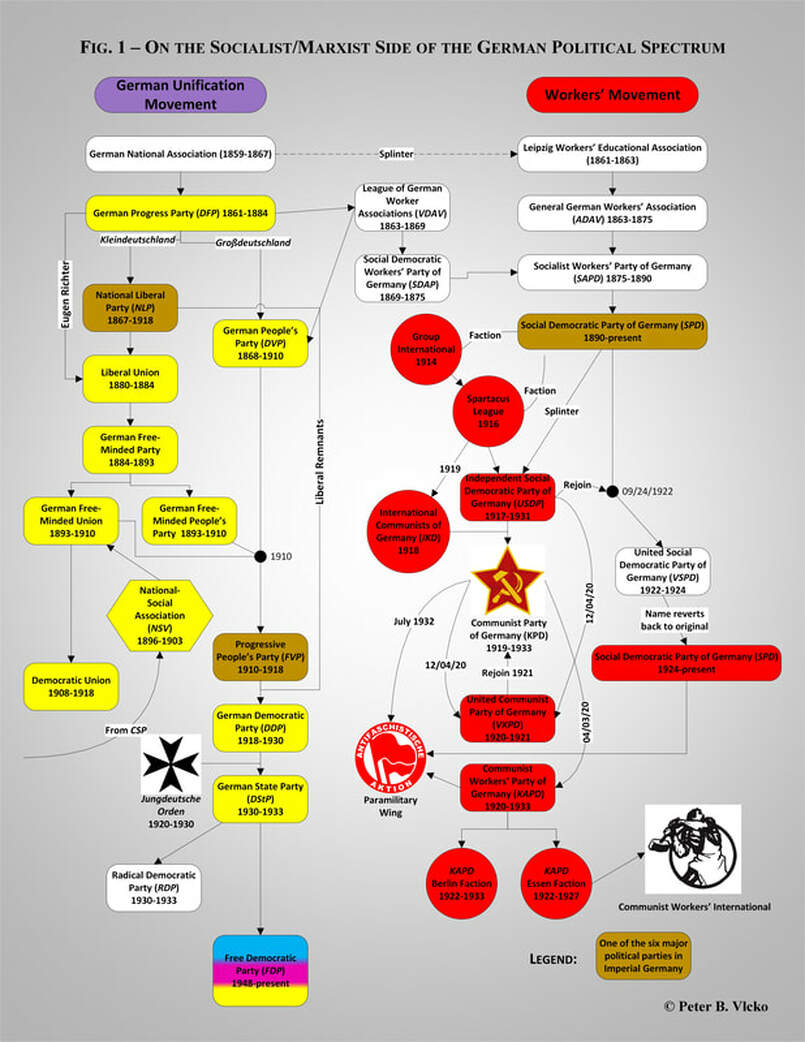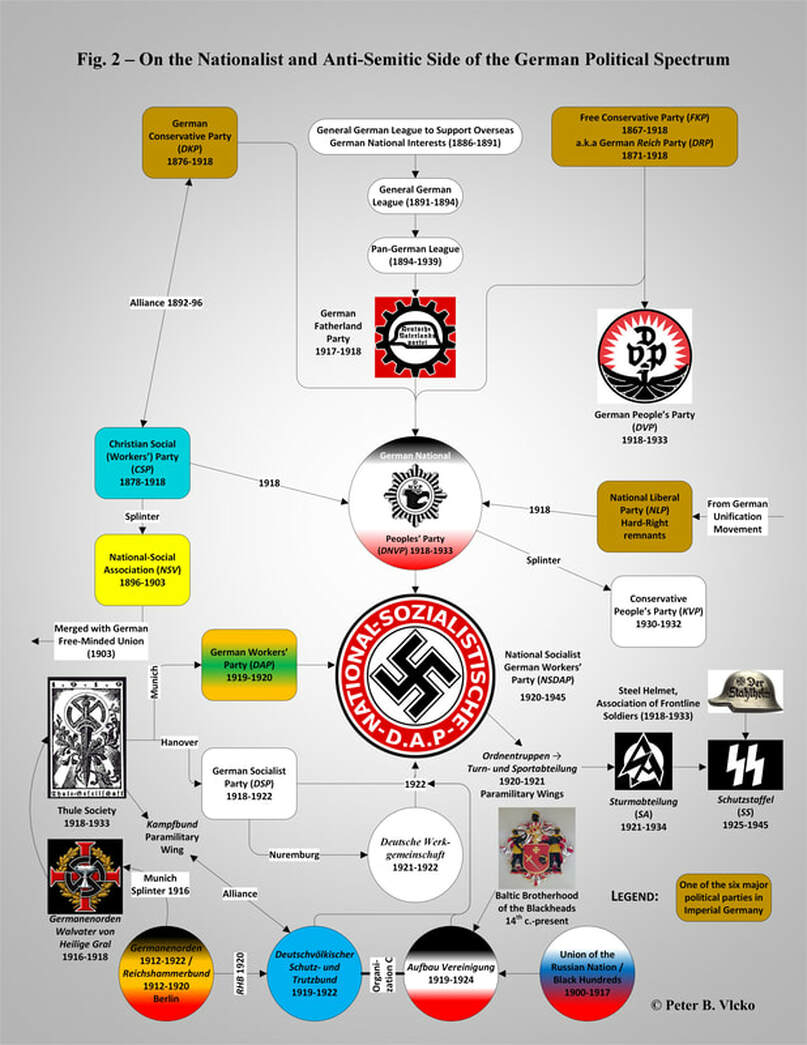The Birth of German Political Parties
Six major political parties were active in Imperial Germany (1871-1933): Free Conservative Party (1867); National Liberal Party (1867); Center Party (1870); German Conservative Party (1876); Social Democratic Party of Germany (1890, SPD); and Progressive People’s Party (1910). Only SPD survived both the Empire and the Weimar Republic and came to play a vital role in the Federal Republic after the Second World War. Even though the German Empire lacked a genuinely Democratic system, the six main parties accurately reflected the interests and hopes of most of its people.
Although many blocs and coalitions were formed between parties in the years 1871 to 1918, these never lasted long enough to become stable “governing coalitions.” The parties were too much at odds to conclusively develop the rights of Parliament or establish a more parliamentary system of government. Moreover, apart from the SPD, which formed the largest parliamentary group in the Reichstag from 1912, no party saw any lasting benefit in constitutional change, and even within the ranks of the Social Democrats there was an ambivalent attitude to parliamentary Democracy.
Not until September 1918 during the closing chapter of the First World War when Germany was on the brink of economic and military collapse, did the majority parties thrust their way into government. The military high command (Oberste Heeresleitung, OHL) under Generals Paul von Hindenburg and Erich Ludendorff did not wish to take responsibility for the defeat, although over the course of the war they had increasingly determined imperial policy and had done so almost dictatorially. For this reason, they were finally willing to compromise with the political parties—of course, in a conscious effort to shift the blame for defeat to the political parties. The advances made by the majority parties and the military high command and, not least, the pressure exerted by President Woodrow Wilson, who did not wish to make peace with anything other than a Democratic government, paved the way for the introduction of parliamentary Democracy. By a large majority, Parliament amended the Imperial Constitution, and on 28 October 1918 the Empire became a parliamentary monarchy, albeit only for a moment. On 9 November 1918, Kaiser Wilhelm II abdicated the throne and Philipp Scheidemann of the Social Democratic Party proclaimed the Weimar Republic from a window in the Reichstag building, thereby completing the constitutional transformation.
The most conservative of the six majority parties was the German Conservative Party, which represented Prussian Nationalism, aristocracy, and landed gentry. Many of its members remained opposed to German unification because they feared Prussia’s gradual subjugation to the Empire. The Conservatives also detested the Reichstag because it was elected by universal male suffrage. The Free Conservative Party represented industrialists and large commercial interests. The views of this party most closely matched those of von Bismarck. Its members supported unification because they saw it as unavoidable. The National Liberal Party was composed of liberal Nationalists who had accepted Germany’s lack of full Democracy because they valued national unity more. They continued to favor a laissez-faire economic policy and secularization. In time, National Liberals became some of the strongest supporters of the acquisition of colonies and a substantial naval buildup, both key issues in the 1880s and 1890s.
Unlike the members of the National Liberal Party, members of the German Progress Party and its two primary offspring remained faithful to all the principles of European Liberalism and championed the extension of parliament’s powers. This party was in the forefront of those opposed to the authoritarian rule of von Bismarck and his successors. The Center Party was Germany’s Roman Catholic party and had strong support in southern Germany, the Rhineland, and in parts of Prussia with significant Polish populations. It was conservative regarding monarchical authority but progressive in matters of social reform.
Formally organized political Liberalism in Germany developed in the 1860s, combining the previous Liberal and Democratic currents. Between 1867 and 1933, Liberalism was divided into liberal progressive (Socialist and Communist) and liberal Nationalist factions. The Socialists and Communists sought a complete break with the monarchal system of rule of the past and the rise of the proletariat class—the Communists sought to replace aristocratic rule with the “dictate of the proletariat”—while the liberal Nationalists sought to liberalize the monarchal aristocratic rule but not eliminate it.
Let us examine how the political party system began and evolved in Germany with some of the more prominent political parties pertinent to our topic. Weaving through the intricacies, strategies, and intrigues of German politics during the late nineteenth and early twentieth centuries is not the intent of this writing. The only interest here is in briefly introducing the various significant political movements and their key players from one ideologically liberal extreme to the other liberal extreme, that facilitated the dramatic developments taking Germany from Empire (First Reich) to the Third Reich. Throughout this discussion it is important to remember that it was Liberalism that was the primary driving force in the political evolution of the period. Many minor, insignificant political movements and parties have been left out of this discussion. Although the following examination may seem tedious, pedantic, and esoteric to some, it is useful to gain insight into the German political movements born of the Enlightenment, 1789 French Revolution, Industrial Revolution, and 1848 Spring of Nations Revolutions that led to the German Revolution and rise of National Socialism.
Although many blocs and coalitions were formed between parties in the years 1871 to 1918, these never lasted long enough to become stable “governing coalitions.” The parties were too much at odds to conclusively develop the rights of Parliament or establish a more parliamentary system of government. Moreover, apart from the SPD, which formed the largest parliamentary group in the Reichstag from 1912, no party saw any lasting benefit in constitutional change, and even within the ranks of the Social Democrats there was an ambivalent attitude to parliamentary Democracy.
Not until September 1918 during the closing chapter of the First World War when Germany was on the brink of economic and military collapse, did the majority parties thrust their way into government. The military high command (Oberste Heeresleitung, OHL) under Generals Paul von Hindenburg and Erich Ludendorff did not wish to take responsibility for the defeat, although over the course of the war they had increasingly determined imperial policy and had done so almost dictatorially. For this reason, they were finally willing to compromise with the political parties—of course, in a conscious effort to shift the blame for defeat to the political parties. The advances made by the majority parties and the military high command and, not least, the pressure exerted by President Woodrow Wilson, who did not wish to make peace with anything other than a Democratic government, paved the way for the introduction of parliamentary Democracy. By a large majority, Parliament amended the Imperial Constitution, and on 28 October 1918 the Empire became a parliamentary monarchy, albeit only for a moment. On 9 November 1918, Kaiser Wilhelm II abdicated the throne and Philipp Scheidemann of the Social Democratic Party proclaimed the Weimar Republic from a window in the Reichstag building, thereby completing the constitutional transformation.
The most conservative of the six majority parties was the German Conservative Party, which represented Prussian Nationalism, aristocracy, and landed gentry. Many of its members remained opposed to German unification because they feared Prussia’s gradual subjugation to the Empire. The Conservatives also detested the Reichstag because it was elected by universal male suffrage. The Free Conservative Party represented industrialists and large commercial interests. The views of this party most closely matched those of von Bismarck. Its members supported unification because they saw it as unavoidable. The National Liberal Party was composed of liberal Nationalists who had accepted Germany’s lack of full Democracy because they valued national unity more. They continued to favor a laissez-faire economic policy and secularization. In time, National Liberals became some of the strongest supporters of the acquisition of colonies and a substantial naval buildup, both key issues in the 1880s and 1890s.
Unlike the members of the National Liberal Party, members of the German Progress Party and its two primary offspring remained faithful to all the principles of European Liberalism and championed the extension of parliament’s powers. This party was in the forefront of those opposed to the authoritarian rule of von Bismarck and his successors. The Center Party was Germany’s Roman Catholic party and had strong support in southern Germany, the Rhineland, and in parts of Prussia with significant Polish populations. It was conservative regarding monarchical authority but progressive in matters of social reform.
Formally organized political Liberalism in Germany developed in the 1860s, combining the previous Liberal and Democratic currents. Between 1867 and 1933, Liberalism was divided into liberal progressive (Socialist and Communist) and liberal Nationalist factions. The Socialists and Communists sought a complete break with the monarchal system of rule of the past and the rise of the proletariat class—the Communists sought to replace aristocratic rule with the “dictate of the proletariat”—while the liberal Nationalists sought to liberalize the monarchal aristocratic rule but not eliminate it.
Let us examine how the political party system began and evolved in Germany with some of the more prominent political parties pertinent to our topic. Weaving through the intricacies, strategies, and intrigues of German politics during the late nineteenth and early twentieth centuries is not the intent of this writing. The only interest here is in briefly introducing the various significant political movements and their key players from one ideologically liberal extreme to the other liberal extreme, that facilitated the dramatic developments taking Germany from Empire (First Reich) to the Third Reich. Throughout this discussion it is important to remember that it was Liberalism that was the primary driving force in the political evolution of the period. Many minor, insignificant political movements and parties have been left out of this discussion. Although the following examination may seem tedious, pedantic, and esoteric to some, it is useful to gain insight into the German political movements born of the Enlightenment, 1789 French Revolution, Industrial Revolution, and 1848 Spring of Nations Revolutions that led to the German Revolution and rise of National Socialism.

